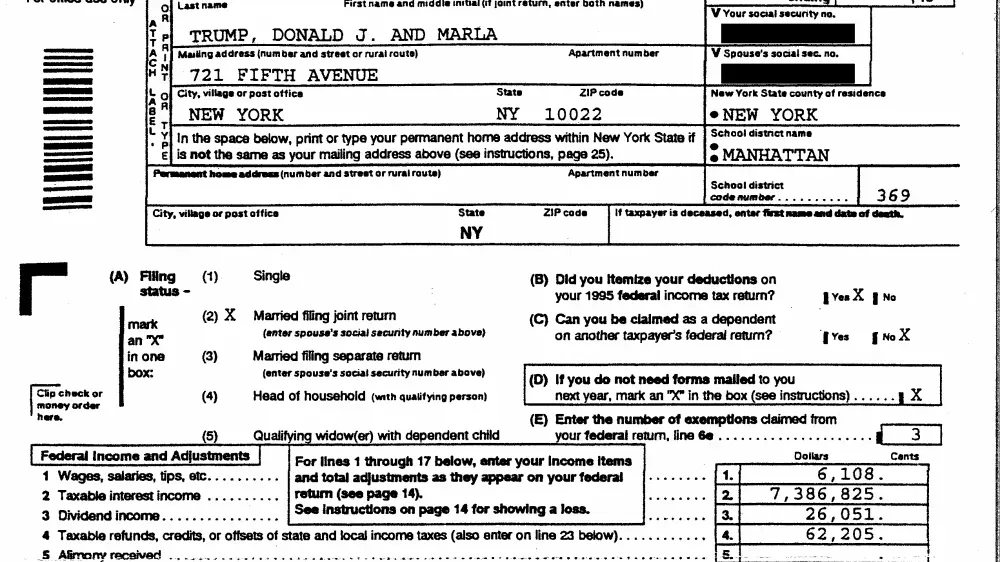Donald Trump income tax claims have sparked significant debate as he asserts that upcoming tariffs could revolutionize the tax landscape for many Americans. In a recent post on Truth Social, Trump emphasized that these import tariffs will not only lower income tax but could potentially eliminate it for individuals earning less than $200,000 per year. His bold statement suggests that the overall economic benefits of tariffs would extend beyond just job creation, aiming to alleviate the tax burden on the middle class. By shifting the focus to domestic manufacturing, Trump’s administration believes that these measures will encourage job creation in the USA, fostering a more robust economy. As discussions continue, it raises pertinent questions about the long-term impact of such financial strategies on both the economy and individual taxpayers.
The claims made by Donald Trump regarding income taxation and economic policy provide a fascinating insight into his administration’s fiscal agenda. The imposition of tariffs, as advocated by Trump, is framed as a strategy to not only boost domestic manufacturing but also to significantly lower individual tax liabilities for many Americans. These financial reforms underscore the ongoing conversation about how tariffs can influence the broader economic ecosystem, including job creation in the USA. By focusing on reducing tax obligations while simultaneously aiming to improve employment rates, the approach highlights the administration’s intentions to reshape the financial landscape for the American workforce. As we explore how these tariffs could potentially benefit taxpayers, it remains crucial to consider the multifaceted implications of such policies.
Donald Trump Income Tax Claims and Their Implications
In a bold assertion on his social media platform Truth Social, Donald Trump claimed that the upcoming tariffs will result in significant income tax reductions for Americans. He emphasized that for many individuals, particularly those earning less than $200,000 annually, there is even a possibility that their income tax could be entirely eliminated. Trump’s message reflects a broader economic strategy aimed at revitalizing the American economy through aggressive fiscal policies and trade reform.
These claims, while optimistic, rest on the premise that tariffs, which function as taxes on imports, will successfully incentivize domestic production. By imposing these tariffs, the expectation is that American companies will be encouraged to base their manufacturing operations in the U.S., thus reducing dependency on foreign imports. If successful, this could lead to an increase in job creation and, as Trump argues, a subsequent reduction in the income tax burden for American workers.
Analyzing the Benefits of Tariffs in Trump’s Economic Model
Donald Trump’s administration has consistently touted the benefits of imposing tariffs on foreign imports as a strategy for economic enhancement. He believes that such measures not only protect American jobs from outsourcing but also stimulate job creation within industries that are vital to the U.S. economy. By levying tariffs, Trump suggests that the government can generate additional revenue, which in turn can offset the need for higher income taxes. This could potentially create a more favorable environment for lower income tax rates for many Americans.
The concept revolves around the belief that as domestic production increases due to reduced foreign competition, more jobs will be created, leading to wage growth and increased tax revenues from employment. Furthermore, Trump has noted that these tariffs will facilitate a revitalized manufacturing sector, thus providing a foundation for a more robust economy. If companies begin building factories in the U.S. as a response to tariffs, this could signify not only job creation but also economic resilience, enhancing the overall tax base.
The Role of Import Tariffs in Reviving the American Economy
Import tariffs play a critical role in Donald Trump’s economic vision, as he has advocated for the placement of significant tariffs to promote local production and protect American jobs. By introducing a 10% tariff on almost all imports, Trump aims to create a competitive advantage for U.S. manufacturers. This could lead to a substantial increase in job opportunities as companies ramp up production to meet domestic demand, effectively boosting the economy and tax revenues.
Moreover, Trump’s tariffs are not just focused on immediate economic benefits; they also serve a strategic purpose by compelling countries like China and India to negotiate better trade terms. His perspective is that such tariffs will revolutionize the American manufacturing landscape, bringing jobs back home and stimulating economic growth, ultimately providing the means to lower income taxes for millions of Americans.
Job Creation USA: The Expected Impact of Trump’s Tariffs
One of the key promises associated with Trump’s tariff strategy is the substantial job creation that is anticipated to follow. By encouraging companies to invest in U.S. infrastructure and production capabilities, Trump argues that tariffs will lead to the establishment of new factories and manufacturing plants across the country. This could potentially result in the creation of thousands of jobs as businesses seek to ramp up domestic production in response to reduced import competition.
Furthermore, job creation is seen as the cornerstone of Trump’s economic policy, leading to increased spending capacity for households. As more Americans gain employment, the overall financial health of the nation could improve, thus enabling discussions around further lowering income taxes. The cycle of reinvestment in the workforce would facilitate a more sustainable economic environment.
Understanding the Connection between Tariffs and Economic Growth
Trump’s assertion that tariffs will lead to economic growth relies on the interconnection between trade policies and domestic production capabilities. By imposing tariffs, the intention is to make imported goods more expensive, encouraging consumers to turn to domestic alternatives. This shift is anticipated to spark increased competition among U.S. businesses, ultimately leading to innovation, enhanced productivity, and overall growth in the economy.
If successful, this model could help in generating additional government revenue that might offset potential decreases in income taxes. The expectation is that a booming economy, driven by robust job growth and increased production, will create the fiscal space needed for sustained tax relief. In essence, Trump’s economic strategy ties aggressive tariff policies to broader goals of economic stability and growth.
The Debate Over Lower Income Tax Rates Under Tariff Policy
One of the most contentious topics in the ongoing discourse regarding Trump’s tariff policy is the claim that it will lead to lower income tax rates. Advocates argue that by increasing domestic production and job creation through tariffs, the U.S. government can reduce reliance on income tax revenue. Lowering income tax rates, particularly for individuals earning under $200,000, could stimulate consumer spending, according to this perspective.
Opponents, however, raise concerns about the sustainability of this approach. They argue that while the intention behind tariffs is to shield American jobs, the long-term effects of increased prices and potential retaliation from trade partners could counteract these gains. The debate continues as to whether this policy will effectively lower income taxes for average Americans or simply lead to increased costs in other areas.
Evaluating the Future of Trump’s Tariff Strategy
As the landscape of U.S. trade and economic policy continues to evolve, the effectiveness of Trump’s tariffs remains a focal point for analysis. The administration’s decision to impose significant tariffs on imports marks a decisive shift in trade policy, aimed at promoting local production and improving job creation. However, the success of this approach hinges on various factors, including global trade dynamics and the response from other nations.
In anticipating the future, it is critical to evaluate both immediate outcomes and long-term results of these tariffs. Will they effectively lead to a more self-sufficient economy, resulting in lower income taxes and enhanced job opportunities, or will they provoke trade disputes that may stifle growth? The continued assessment of these strategies will be crucial in determining their ultimate impact on the American economy.
Trump’s Tariffs and Their Global Economic Implications
The tariffs introduced by Donald Trump have implications that extend beyond the borders of the United States. By targeting specific countries like China and India with steep tariffs, Trump aims to shift the dynamics of global trade. This approach not only affects the U.S. economy but also has far-reaching consequences for international markets and trade relationships, potentially leading to changes in the way global commerce is conducted.
As other nations react to U.S. tariffs, the resulting economic shifts could lead to a reconfiguration of trade alliances and disputes. The impact on import tariffs in the USA raises questions about how global supply chains will adapt and respond to increased costs. Understanding these global dynamics is essential for comprehending the broader ramifications of Trump’s economic policies and their capacity to shape future trade relations.
The Political Ramifications of Tariff Policies
The imposition of tariffs by Donald Trump has not only economic implications but also significant political ramifications. By aligning his tariff policies with promises of job creation and lower income taxes, Trump seeks to cement his support among key voter demographics, particularly those in manufacturing sectors. The political narrative surrounding these policies is a crucial aspect that influences public opinion and election outcomes.
As communities begin to feel the effects of these tariffs—both positively through job creation and negatively through increases in consumer prices—the political landscape could shift. The balance of support for Trump’s tariffs hinges on the perceived benefits they bring to everyday Americans, making it a pivotal matter as the country navigates its economic future.
Frequently Asked Questions
How do Donald Trump’s income tax claims relate to tariffs and tax reductions?
Donald Trump’s income tax claims suggest that the imposition of tariffs could lead to a reduction in income tax for many Americans. In his statements, he indicated that the revenue generated from these tariffs could allow for lower income taxes, potentially even eliminating them for individuals earning less than $200,000 annually.
What are the potential benefits of tariffs according to Donald Trump’s statements on income tax?
According to Donald Trump, the benefits of tariffs include not only a decrease in income tax for some Americans but also the creation of new jobs. He asserts that tariffs will encourage manufacturing within the US, leading to job creation as companies invest in new factories and plants.
What is the relationship between Trump tariffs and job creation in the USA?
Trump tariffs are claimed to contribute to job creation in the USA by incentivizing companies to establish manufacturing facilities domestically. The expectation is that as tariffs reduce imports, local production will increase, thereby generating thousands of new jobs.
Will Trump’s claims about lower income taxes be beneficial for those making under $200,000?
Yes, Trump’s claims suggest that the implementation of tariffs could lead to significant reductions in income tax for individuals making under $200,000. He has mentioned that many in this income bracket could potentially see their income taxes eliminated altogether.
What types of import tariffs did Trump implement, and how might they impact income tax claims?
Donald Trump implemented a series of import tariffs, including a 10 percent tariff on most imports and higher tariffs on specific countries like a 145 percent tariff on China. These tariffs are expected to generate revenue, which Trump argues could be used to reduce income tax burdens for Americans.
What is Donald Trump’s perspective on the long-term impact of tariffs on the US economy?
Donald Trump posits that maintaining high tariffs on foreign imports will result in a ‘total victory’ for the US economy by generating significant revenue and promoting domestic manufacturing. This, he claims, will help reduce income tax rates while also revitalizing job creation.
How does Trump justify the assertion that tariffs will lead to reduced income taxes?
Trump justifies the assertion that tariffs will reduce income taxes by claiming that the funds generated from tariffs can offset the government’s tax revenue needs, effectively lowering the tax burden on citizens, particularly those in lower income brackets.
Can tariffs entirely eliminate income tax, as claimed by Donald Trump?
While Trump has suggested the possibility of completely eliminating income tax for certain individuals through the revenue generated by tariffs, it remains to be seen how feasible this claim is in practice, as it depends on the economic impact and success of tariff implementation.
| Key Points | Details |
|---|---|
| Trump’s Tariff Claims | Trump states that tariffs will lead to a decrease in income tax for Americans. |
| Impact on Income Tax | He claims many will see a reduction, with some potentially having their taxes completely eliminated, especially those earning under $200,000. |
| Job Creation | Trump emphasizes that new plants and factories are being built, leading to thousands of new jobs. |
| Tariff Rates | On April 2, tariffs of 10% on imports were introduced, with specific increases for countries like India (26%) and China (145%). |
| Long-term Vision | Trump believes maintaining high tariffs can be a ‘total victory’ for the U.S. economy by reducing foreign competition. |
Summary
Donald Trump income tax claims have sparked significant discussion, as he asserts that the implementation of tariffs will lead to a reduction in income taxes for many Americans. He emphasizes that this reduction may even lead to complete elimination of income tax for individuals earning under $200,000. Trump’s proposal hinges on the belief that tariffs will foster domestic job creation and bolster the economy by encouraging companies to manufacture within the United States. While the success of these claims remains to be seen, they reflect Trump’s ongoing strategy to reshape American trade and tax policy.




